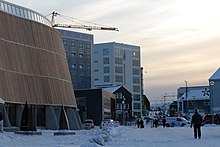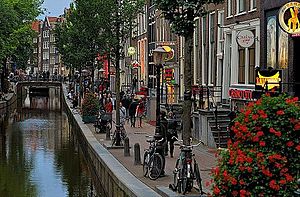Portal:Cities
The Cities Portal

A city is a human settlement of a notable size. The term "city" has different meanings around the world and in some places the settlement can be very small. Even where the term is limited to larger settlements, there is no universally agreed definition of the lower boundary for their size. In a more narrow sense, a city can be defined as a permanent and densely settled place with administratively defined boundaries whose members work primarily on non-agricultural tasks. Cities generally have extensive systems for housing, transportation, sanitation, utilities, land use, production of goods, and communication. Their density facilitates interaction between people, government organizations, and businesses, sometimes benefiting different parties in the process, such as improving the efficiency of goods and service distribution.
Historically, city dwellers have been a small proportion of humanity overall, but following two centuries of unprecedented and rapid urbanization, more than half of the world population now lives in cities, which has had profound consequences for global sustainability. Present-day cities usually form the core of larger metropolitan areas and urban areas—creating numerous commuters traveling toward city centres for employment, entertainment, and education. However, in a world of intensifying globalization, all cities are to varying degrees also connected globally beyond these regions. This increased influence means that cities also have significant influences on global issues, such as sustainable development, climate change, and global health. Because of these major influences on global issues, the international community has prioritized investment in sustainable cities through Sustainable Development Goal 11. Due to the efficiency of transportation and the smaller land consumption, dense cities hold the potential to have a smaller ecological footprint per inhabitant than more sparsely populated areas. Therefore, compact cities are often referred to as a crucial element in fighting climate change. However, this concentration can also have significant negative consequences, such as forming urban heat islands, concentrating pollution, and stressing water supplies and other resources. (Full article...)
Selected city -

Nuuk (Greenlandic pronunciation: [nuːk] ⓘ; Danish: Nuuk, formerly Godthåb [ˈkʌtˌhɔˀp]) is the capital of and most populous city in Greenland, an autonomous territory in the Kingdom of Denmark. Nuuk is the seat of government and the territory's largest cultural and economic center. The major cities from other countries closest to the capital are Iqaluit and St. John's in Canada and Reykjavík in Iceland. Nuuk contains a third of Greenland's population and its tallest building. Nuuk is also the seat of government for the Sermersooq municipality. In January 2023, it had a population of 19,604. Nuuk is considered a modernized city after the policy began in 1950.
The city was founded in 1728 by the Dano-Norwegian missionary Hans Egede when he relocated from the earlier Hope Colony (Haabets Koloni) where he arrived in 1721. The governor Claus Paarss was part of the relocation. The new colony was placed at the Inuit settlement of Nûk and was named Godthaab ("Good Hope"). "Nuuk" is the Greenlandic word for "cape" (Danish: næs) and is commonly found in Greenlandic place names. It is so named because of its position at the end of the Nuup Kangerlua fjord on the eastern shore of the Labrador Sea. Its latitude, at 64°11' N, makes it the world's northernmost capital, only a few kilometres farther north than the Icelandic capital Reykjavík. When home rule was established in 1979, the authorization of place names was transferred to Greenlandic authorities, who subsequently preferred Greenlandic names over Danish ones. The name Godthåb mostly went out of use over the next two decades. (Full article...)Did you know -
- ... that some members of the formerly all-male University Club of New York voted to reject women from membership to protest a New York City law that would have required it?
- ... that a feng shui consultant convinced Donald Trump not to use a gold color for New York City's Trump International Hotel and Tower?
- ... that the Lyceum Theatre is New York City's oldest continuously operating legitimate theater?
- ... that Baku was the last major city to hold municipal elections in 1917 Russia, with the delayed voting occurring after the beginning of the October Revolution?
- ... that at New York City's Apollo Theater, amateurs could be swept off the stage?
- ... that a Kansas City TV station sold for $1 in 1953?
Related portals
Related WikiProjects

Missoula (/mɪˈzuːlə/ ⓘ mih-ZOO-lə; Séliš: Nłʔay, lit. 'Place of the Small Bull Trout'; Kutenai: Tuhuⱡnana) is a city in and the county seat of Missoula County, Montana, United States. It is located along the Clark Fork River near its confluence with the Bitterroot and Blackfoot Rivers in western Montana and at the convergence of five mountain ranges, thus it is often described as the "hub of five valleys". The 2020 United States Census shows the city's population at 73,489 and the population of the Missoula Metropolitan Area at 117,922. Missoula is the 2nd largest city and metropolitan area in Montana. Missoula is home to the University of Montana, a public research university.
The Missoula area began seeing settlement by people of European descent in 1858 including William T. Hamilton, who set up a trading post along the Rattlesnake Creek, Captain Richard Grant, who settled near Grant Creek, and David Pattee, who settled near Pattee Canyon. Missoula was founded in 1860 as Hellgate Trading Post while still part of Washington Territory. By 1866, the settlement had moved east, 5 miles (8 km) upstream, and had been renamed Missoula Mills, later shortened to Missoula. The mills provided supplies to western settlers traveling along the Mullan Road. The establishment of Fort Missoula in 1877 to protect settlers further stabilized the economy. The arrival of the Northern Pacific Railway in 1883 brought rapid growth and the maturation of the local lumber industry. In 1893, the Montana Legislature chose Missoula as the site for the state's first university. Along with the U.S. Forest Service headquarters founded in 1908, lumber and the university remained the basis of the local economy for the next 100 years. (Full article...)Selected article -

General images -
Topics
List articles
Subcategories
Associated Wikimedia
The following Wikimedia Foundation sister projects provide more on this subject:
-
Commons
Free media repository -
Wikibooks
Free textbooks and manuals -
Wikidata
Free knowledge base -
Wikinews
Free-content news -
Wikiquote
Collection of quotations -
Wikisource
Free-content library -
Wikiversity
Free learning tools -
Wiktionary
Dictionary and thesaurus







































